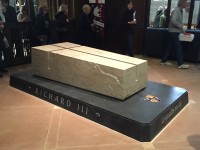
Richard III’s tomb at Leicester Cathedral. Photo by Isananni
One year ago, Richard III, one of England’s most notorious kings, was reburied at Leicester Cathedral after a series of celebrations and ceremonies suitable for a national hero. Actor Benedict Cumberbatch even read a poem written by Poet Laureate Carol Ann Duffy. Fortunately for him, the poem did not include the word “penguin” (also here). To commemorate the anniversary, the University of Leicester has released a 3D model of Richard’s skeleton in its original, too-short, poorly-dug grave.

Richard III, child-killer and national treasure
Amid all the hoopla, it’s easy to forget that Richard III was not the People’s Princess, but rather a man who almost certainly ordered the murder of two children, both of whom were his nephews and one of whom was probably the rightful king of England. I’ve been interested in the way Richard’s image has been rather successfully rehabilitated through the publicity surrounding the discovery of his remains and their reburial. For the moment, though, I’m going to focus on one element of the story: the way the search for and discovery of the body has itself become mythologized, possibly with the help of a faulty memory.
Amateur historian Philippa Langley deservedly gets much credit for the discovery of Richard’s bones. Without her determination and fundraising, Richard’s grave may never have been found. To a large extent, however, Richard’s story has become Phillipa’s story: a story of intuition and semi-mystical experiences, a story that trumps the more cautious, skeptical approach of archaeologists, historians, and scientists who tend to act on evidence rather than feelings. Of course, the archaeologists and scientists have gotten credit for the fine work they’ve done, but there is a sense that their role has been to confirm Langley’s intuitions.
“I Absolutely Knew I Was Standing on His Grave.”
After Richard was killed at the Battle of Bosworth Field, his body was taken to nearby Leicester and buried at the Franciscan friary, Greyfriars. After the Dissolution of the Monasteries, Greyfriars was demolished and its exact position forgotten. There were various rumors that the body had been moved at some point and perhaps tossed into the River Soar. Even if it remained in situ and hadn’t been damaged or rendered inaccessible through later construction, no one knew exactly where it was.
Philippa Langley became interested in Richard as a teenager. In time, she evolved into a dedicated Ricardian, one who believes that Richard’s reputation was unfairly tarnished by Tudor propaganda and Shakespeare’s portrayal of him in Richard III. Ricardians also disagree with many modern historians’ assessments of Richard’s acts and character. Langley joined the Richard III Society and is the founder of its Scottish branch. In May 2004, Langley visited the site of Bosworth and then continued to Leicester. As she explains in her book The King’s Grave: The Discovery of Richard III’s Lost Burial Place and the Clues It Holds, she “wanted to explore the city and see it as Richard might have done” (p. 4). Among the places she visited was the New Street parking lot. Local Ricardians had told her that it contained some medieval stonework that might have belonged to Greyfriars. Some people had speculated that Richard might have been buried beneath the lot. Langley describes the lot as “a tarmacked expanse of wasteland” (King’s Grave, p. 4). While there, she saw the stonework and “tried to get a feel for what it would have been like in Richard’s day, how it might have looked, but nothing remained here of the past. I felt no resonance with Richard’s life, or death” (p. 4).
She was about to move on when she saw another parking lot. This one was the Leicester City Council Social Services staff parking lot. It was marked “private” and had a barrier. Here she experienced “an overwhelming urge to enter” (King’s Grave, p. 4). She slipped past the barrier and, instead of medieval stonework, she saw a Victorian red brick wall:
I found myself drawn to this wall and, as I walked towards it, I was aware of a strange sensation. My heart was pounding, my mouth was dry—it was a feeling of raw excitement tinged with fear. As I got near the wall, I had to stop, I felt so odd. I had goose-bumps, so much that even in the sunshine I felt cold to my bones. And I knew in my innermost being that Richard’s body lay here. Moreover I was certain that I was standing right on top of his grave. (King’s Grave, p. 5)
Langley has told this story many times now, and she always uses very similar language to describe this extraordinary experience. On NPR she explained:
[At the first parking lot, t]here was a piece of a 15th century wall. So I went and had a look at the wall but I got no sense of the past to there [sic], so I left to go home. But as I did, I saw another carpark opposite…and just had this overwhelming urge to go into it. And in a certain place in this carpark, I felt as though I was walking on his grave. I think the only way I can describe it is just, like, having goosebumps because it made me feel cold even though it was a really warm day, I was actually cold.
She told archaeologist and journalist Mike Pitts:
I was drawn to a red brick wall ahead of me, and as I walked towards it I had to stop, because I had the strangest sensation. It was a warm day, but I had goosebumps so badly I was actually freezing cold to my bones. I knew then. I absolutely knew I was standing on his grave. (Pitts, Digging for Richard III, location 741)
A year later, she returned and had the same experience, but now she saw, slightly to the left of where she “knew” Richard was buried, the letter “R.” The “R” had been painted there to indicate the parking space was reserved, but, as she explained to the Guardian, she interpreted it as a sign that she “needed to get on with it,” “it” being the quest to find and recover Richard’s remains. Oddly, in her NPR interview, the discovery of the “R” seems to occur during the first visit. No subsequent visit is mentioned.
A King Discovered
Langley spent years raising money and trying to find archaeologists to excavate the site. She also found a film crew to document the search. She finally reached an agreement with the University of Leicester Archaeological Services (ULAS). The archaeologists, including lead archaeologist Richard Buckley and fieldwork director Matthew Morris, were primarily interested in discovering the medieval church.
On the first day of the excavation, not far from where the “R” had been, a mechanical digger exposed a bone. It turned out to be two human leg bones, close together, indicating it might be a burial rather than a single stray bone. The archaeologists were pleased to find the burial because it suggested that they were on the right track, but they were not overly excited. They covered the leg bones and continued excavating. Much later, after they had gotten a good idea of the position of the church and realized the bones might be within the choir, they had osteologist Jo Appleby excavate the skeleton. As she began to expose the spine, she found that it was extremely curved. Langley was distressed by this information because it has been a Ricardian article of faith that Richard was not a hunchback and suffered no significant skeletal deformity. Everyone else was ecstatic, thinking they might really have found Richard. Injuries to the skull reinforced the identification. The University of Leicester spent a vast amount of money to perform every scientific test imaginable on the skeleton. These tests proved that the skeleton did, indeed, belong to Richard III. And his body had lain exactly where Langley had had her extraordinary experience.
Or did it? Of course, extraordinary coincidences do happen without any cosmic intervention. And some of the coincidences may not have been all that extraordinary. For instance, it isn’t really all that extraordinary that a parking spot was marked to indicated that it was reserved. In addition, you will notice that the “R” was not directly above Richard’s bones: it was near them. Specifically, it was about 15 feet to the north of the grave (Pitts, Digging for Richard, location 3670, n. 9). Furthermore, it may not be a particularly extraordinary coincidence that the bones were found in the Social Services parking lot. At least one person (Audrey Strange) had published an article that suggested that the bones might be under one of three parking lots (Pitts, Digging for Richard, location 975). The Leicester Ricardians had pointed Langley to the New Street lot, but it’s possible she had read about the Social Services lot while doing research on Richard, whether she consciously remembered it or not.
Memory is malleable. Every time we remember an event, we recreate it.
The largest coincidence remains, though: that Langley was positive she was standing on Richard’s grave when she was indeed standing on Richard’s grave. I have to admit, I’m a bit skeptical of this part of the story. I don’t think Langley is lying, but I think her memory may be faulty. More than eight years had passed between her mystical experience and the excavation of the grave. Was she exactly on the spot of the grave? Did the appearance of the “R” affect her memory? Did her experience occur at the “R”? Fifteen feet to the south of the “R” (where the grave actually was)? Or somewhere else?
Diverging Memories
I suppose there is no way to know exactly what she experienced on her first visit or how her memory of the details may have changed over the years. Is there any good reason to question her memory? Well, yes, there’s good reason to question everyone’s memory. Memory is malleable. Every time we remember an event, we recreate it. We are actually remembering the last time we remembered the event, rather than remembering the event itself. The memory can become corrupted each time it is recalled.
Is there any reason to question Langley’s memory specifically? Possibly. I have read two books about the discovery of Richard’s grave. One is Langley’s first-person account, The King’s Grave; the other is Digging for Richard III: The Search for the Lost King by Mike Pitts, an archaeologist and editor of British Archaeology. He wasn’t involved in the dig, but he interviewed everyone who was, including Langley. I have also watched the documentary Secrets: Richard III Revealed, which uses footage from Richard III: The King in the Car Park. Langley was an associate producer of The King in the Car Park. There are significant discrepancies between Langley’s recollection and accounts of others, but one is particularly telling.
This is how Pitts describes the initial discovery of a bone:
There were a couple of concrete slabs that were just too big for the bucket [of the digger] to rip out, so at first the digger had to go over them. Now he worked one loose. As the beam rose like a lid opening, Matthew [Morris, the site director] could see a bone sticking out of the section, the side of the trench: the concrete slabs had protected it at the first machine pass. That looks a bit human, he thought, watching from high up. Which, he soon confirmed, it was. He covered it with a plastic finds bag, and protected it with soil and brick. They would return when the finer excavation began. (Pitts, location 1567)
Later, the digger lost a rubber track. While it was being repaired, Morris inspected the bone more closely and found the second leg bone. Based on Pitts’ account, it seems that Langley only became aware of the bone after the digger had lost the track. According to Langley’s account, the bone wasn’t uncovered until after the track had been replaced:
[S]uddenly Matthew Morris’s hand shoots into the air. The excavator stops and Morris jumps into the trench. He looks up at me.
There’s a bone.
…. I realize that Morris’s head, poking out at me from the trench, is only a few feet from where the letter “R” once existed and right where I had my intuition. My heart is pounding. I feel odd, as if I’m somehow here but not here. My legs are moving, taking me to the edge of the trench. I’m jumping in, getting to Morris as fast as I can. (Langley, pp. 62-3)
In Langley’s account, she frequently gets excited and jumps into trenches. This is generally considered bad form on an archaeological dig. On the British archaeology show Time Team, lead field archaeologist Phil Harding often yells at host Sir Tony Robinson (Badrick from Blackadder) for jumping into trenches without being invited. Since Langley raised the money for the excavation, I imagine she would have been much more politely chided, but I doubt she was encouraged to leap into a trench whenever she wished. The editing of the documentary makes it impossible to work out the sequence of events and discover which account is more accurate. It certainly doesn’t show Langley jumping into the trench, but, in a set piece clearly arranged for the camera, she is shown standing in the trench with Morris quite calmly discussing the discovery of the two leg bones.
According to both books, a sudden violent storm arose not long after the bones had been found. This is Langley’s account:
Everyone is rushing for cover. I yell at Morris to get something to cover the bones with, the fear of losing the DNA coursing through me. [Ricardian] Annette Carson shouts that she’s got bubble wrap, her voice as panicked as mine…. I sprint while putting on a luminous protective coat, jumping into the trench while Morris hurls down some large plastic finds bags…. Everyone’s under cover but I can’t leave the trench. The remains must be protected.
Knowing that we shed DNA continually, from a distance I hurriedly place the plastic bags over the bones as best I can so as not to contaminate them, grabbing clods of the heavy earth to cover the plastic sheeting—anything to stop the rain getting in. I pick up some rocks to place them around the covering, away from the bones, but close enough to hold the plastic bags in place as a wind whips up from nowhere and thunder rumbles overhead. I’m covered in mud, soaked to the skin but the bones are now protected. I’m strangely exhilarated as I race for the nearest cover. Morris is sheltering in the covered walkway and I witter on about how Shakespeare would have loved this scene; he looks at me as if I’m barking mad. (Langley pp. 64-5)
And here is how Pitts describes it, using Morris as his source:
“They [the rest of the diggers] all legged it,” said Matthew, grabbing coats and heading to the gazebo or corners of old buildings around the car park. He climbed out of the trench to fetch something to cover the bones. When he got back, he found Philippa in his waterproof jacket; she left him there and ran for shelter…. [The film crew] ducked under cover as well, from where they could film Matthew getting soaked….
Matthew was concerned that the water would wash out the burial. He stayed there to cover it up, laying down clean plastic finds bags, padding them with soil and holding them down with bricks, nursing the bones while the storm rumbled and flashed over Leicester. The idea that the grave might be Richard’s hadn’t entered his head. (Pitts, location 1604)
There are certain similarities in these two accounts: someone covered the bones during the downpour while everyone else headed for cover. Both accounts talk about padding the finds bags with soil and weighting them down with bricks or rocks. A waterproof jacket was involved. The only significant difference is the protagonist. In Langley’s account, it is Langley who saves the day. In Pitts’ version, it is the site supervisor who gets even wetter after Langley takes his jacket.
Whose account more closely resembles the truth? Although the documentary crew apparently filmed the storm, it isn’t included in the finished product. The thing is, one version makes sense, and the other doesn’t. If a storm threatens finds at an archaeological dig, it makes sense that the site supervisor, a professional archaeologist, would do his job and protect the finds while others seek shelter and amateurs stay out of the way. It makes no sense that an amateur who doesn’t know what she’s doing and could potentially cause more harm than the storm would jump into the trench to save the day while the site supervisor watches from the safety of a covered walkway. Langley’s concerns about contamination are relevant. In Pitts’ account, when Morris returns to the bones while the digger is being repaired, he is wearing rubber gloves: “If it [the find] did turn out to be significant, they would have to DNA test it. He couldn’t risk exposing loads of bone and contaminating it with his own DNA. It was a policy in the written scheme of investigation” (Pitts, location 1591). If Langley wasn’t wearing gloves when she allegedly covered the bones (and why would an observer be wearing gloves?), she was breaking protocol and risking contamination.
Langley remembers the event. In some ways she remembers it very accurately. But her strong emotional attachment to the story and to the fate of Richard’s remains may have caused her to reverse roles and place her in the position of hero. This is not the only example where her memory of events seems questionable, but it is an extremely striking one. Such occasions where she seems to remember what she wants to be the truth again cause me to be skeptical of her account of her experience in 2004. Maybe she had an almost paranormal experience of intuition on the exact spot of Richard’s grave. Maybe. Or maybe her experience was a few feet to the left. Or perhaps a step to the right. Maybe there was a car parked over Richard that day. We will never know, but Philippa Langley’s story has become part of the history and mythology of Richard III.
References
- Langley, Philippa and Michael Jones. The King’s Grave: The Discovery of Richard III’s Lost Burial Place and the Clues It Holds. Macmillan, 2013. Kindle edition. Page numbers are approximate.
- Pitts, Mike. Digging for Richard: The Search for the Lost King. Rev. and expanded ed. Thames and Hudson, 2015. Kindle edition. Location numbers are approximate.
- Secrets: Richard III Revealed. Smithsonian Channel. Dir. Dick Bower, Pete Woods. Prod. Dick Bower. 2013.
Picture Credits:
- Richard III’s New Tomb at Leicester Cathedral by Isananni. Uploaded to wikipedia by Isananni. CC BY-SA 3.0
- Earliest surviving portrait of Richard III, painted c. 1520 from lost original. Owned by the Society of Antiquaries, London. By Unknown artist; uploaded to wikipedia by Silverwhistle – Richard III Society website via English Wikipedia, Public Domain, https://commons.wikimedia.org/w/index.php?curid=20472954











I was expecting some counter-evidence about the DNA analysis and the identification of the hunched skeleton as Richard III. instead, I plenty silly analyses about Langley recollections. Who cares about her chilled bones, her goosebumps, the R in the parking lot, and who protected the bones from the rain?
If in the end she was instrumental in organizing the dig, and the bones are indeed those of Richard III, what does it matter if the bones were found 1 or 15 feet from the R?
Nitpicking of that natures is plain ol’ silly and proves that even skeptics are (or can be) inflicted with the Silly Bug. I dread to think of the hours the writer spent on researching her material for this article. She could have spent it more productively helping in a dog rescue shelter, for example.
Jackie. I thought you were making some pretty objective points til you just had to for some reason bring your bias into the argument ( Fox News). I’m skeptical of people who ( like you) have the mindset that if you question the left ……. then you’re biased. But of course. Not you.
“a man who almost certainly ordered the murder of two children” – really? Where is the skeptic in you? Not that this was the point of your article, but you did say it. All we have to go on is propaganda (contemporary historians belonged to the Tudors, which makes them about as unbiased as Fox News), on the one side, and assumptions about motives and the behavior of people who knew him, on the other. Certainly nothing scientific.
By the way, let’s not forget that, if Richard III was no saint, he was responsible for far fewer deaths than some other English kings – including his victor’s son, Henry VIII.
I agree with August Gerard Schwartz. What matters here is not Ms Langley’s memory (even if it’s not faulty, it obviously has everything to do with a mere coincidence and not with anything paranormal), but the fact that a significant archaeological discovery was made. All the rest is not silence, as The Bard said, but rather, to quote a French poet – yes, we have writers – and skeptics – too in France -, “literature”.
A few things: 1). To characterize a 15′ difference as not being precisely where the bones were found is definitely quantifiably “precise” but to have found the bones within a parking space away seems quite remarkable. 2). Id call Ms Langley’s “Memory” of this instance more a “Dramatic Manifestation” than a memory though would not here account be a Primary Source account and Pitts’ not? So then which should history tend to believe closer to the fact? 3). Ms Langley is certainly a romantic, (as likely are all members of the Richard III club, and equally as likely are NOT members of any Skeptical Society), so I dont doubt that at any opportunity one like her would jump into a trench dug by a large mechanical backhoe – this, (her frequent jumps), ought not though diminish the quality of the dig – since most sensitive Archeological explorations are not done with giant meta claws. The brilliance, and fact, of the search effort is that it paid off quickly and with little effort; to attempt to discredit how that happened, using what seem like curiously petty criticisms, seems, pettier. Still, I did enjoy this writing.